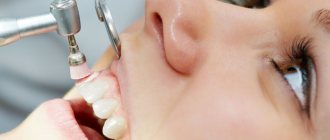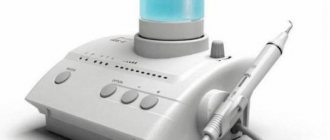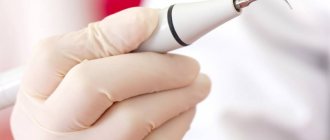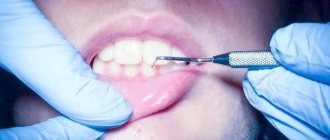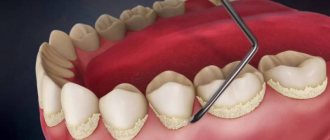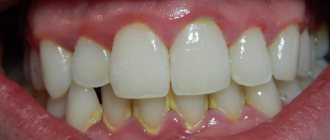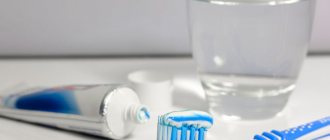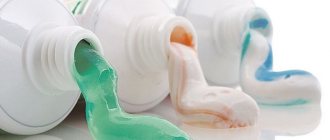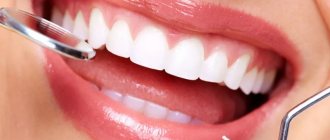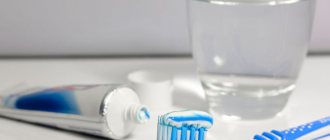What is tartar and what are the causes of its appearance?
Tartar is hardened plaque that forms on the visible part of the tooth (crown) and under the gum.
The reasons for its appearance are natural, but the consequences can cause pathologies in the oral cavity.
Initially, food particles stick to the enamel. Bacteria begin to actively multiply in them. A dental plaque is formed, which looks like a soft, light plaque. Plaque can be easily removed by regular tooth brushing. But if this does not happen, then food debris, dead cells of the mucous membrane, calcium and phosphorus salts from saliva are layered on the soft plaque. They crystallize and harden.
Mineralization occurs on average within 12 days. Soft plaque turns into hard plaque. Tartar has a rough surface, onto which more and more elements “cling.”
Attention: A bacterial film on teeth forms within 16 hours. Therefore, it is important to brush your teeth at least twice a day.
Photo of plaque, male jaw
Why hard deposits form
Plaque formation is inevitable, but there are a number of factors that accelerate the process:
- Irregular hygiene. Particularly active formation of plaque and stone occurs at night: salivation decreases, a person swallows less often, and does not move the tongue. This creates a favorable environment for bacterial growth.
- Poor hygiene. Brushing teeth with horizontal movements does not affect hard-to-reach areas. The interdental spaces should be cleaned by moving the brush vertically.
- Diet. A large amount of sweet and starchy foods leads to the sticking of carbohydrates to the enamel and the proliferation of pathogenic microflora. To reduce the rate of plaque formation, you should eat fresh, firm vegetables and fruits. Chewing the fibrous pulp for a long time partially helps remove plaque.
- Physiological features. Incorrect bite and crowded teeth make proper cleaning difficult.
- Metabolic disorders. The composition of saliva changes, its bactericidal properties decrease.
- Smoking. Cigarette tar settles on the teeth, causing the formation of films and plaques.
Caring for your teeth after ultrasonic cleaning
After the procedure, especially if a lot of plaque has been removed, there is a slightly increased sensitivity of the teeth to temperature and chemical irritants, so for 24 hours after cleaning, patients are advised to refrain from eating excessively hot, cold, sour and salty foods. It is advisable to follow a “white diet” for a couple of days, as after teeth whitening, to exclude strongly coloring foods from the diet (red wine, coffee, black tea, beets, some bright fruits and juices from them) so that the cleaned enamel does not absorb food dyes, and on the contrary, enrich it with solid and fiber-containing products that will prevent the appearance of plaque and stones (fruits, vegetables, nuts, etc.).
If sensitivity is severe, it is recommended to replace your regular toothbrush with a soft-bristled brush for several days and purchase toothpaste that reduces sensitivity.
After each meal, you need to rinse your mouth with clean water - this rule must be observed not only after ultrasonic cleaning, but also constantly.
On the first day or two, it is also recommended to brush your teeth after every meal.
Why is ultrasonic cleaning necessary?
Professional teeth cleaning in a clinic identifies problem areas and helps avoid future diseases.
- Detects caries. The destruction of enamel and dentin can be hidden under a layer of tartar. If caries is discovered later, it should be cured.
- Prevents the formation of new caries, including those who wear braces.
- Prevents gum inflammation, periodontitis, exposed roots, bleeding, and bad breath.
- Prepares the oral cavity for surgery and implant installation. Removing colonies of bacteria living in dental plaque ensures the safety of manipulations that violate the integrity of tissues.
- Brightens teeth without aggressive chemical whitening.
Photos BEFORE and AFTER cleaning
How to deal with inflammation?
To prevent or eliminate gum inflammation after professional tartar cleaning, it is important to follow your dentist's recommendations.
- After professional oral hygiene, do not consume hot and cold foods and drinks for 2-3 hours, coffee and juices for about 12 hours.
- Avoid roughage and solid foods for a day.
- Buy a new toothbrush with soft bristles to prevent injury to the gum tissue.
- Take biocomplexes with a balanced composition, which includes vitamins A, PP, D, as well as phosphorus and calcium.
To prevent complications and re-formation of dental plaque, regularly perform professional oral hygiene and visit your dentist every 6 months.
Is ultrasonic teeth cleaning harmful?
Ultrasonic cleaning does not pose any threat to teeth and the body as a whole. An exception is situations in which the technology is broken or the patient has contraindications. Ultrasound can damage enamel if it is thinned or has such a structural feature. Sometimes brushing causes bleeding from the gums. The doctor will help stop it and advise what needs to be done for speedy healing.
Advice: to avoid possible troubles, before starting the procedure, the dentist finds out the state of health, concomitant diseases, and reaction to medications. Answer honestly and directly, every nuance matters.
Frequently asked questions about ultrasonic teeth cleaning
Does ultrasonic cleaning help whiten teeth?
Ultrasonic dental cleaning cleans dental surfaces from hard and soft plaque, but does not significantly whiten the enamel. The enamel becomes lighter by 1-2 tones due to the use of Air Flow technology and teeth polishing after ultrasonic cleaning. If you want a more pronounced whitening effect, you can carry out a specialized procedure after cleaning.
Is it true that after brushing your teeth with ultrasound, plaque appears on your teeth faster?
No that's not true. Quite the opposite - after ultrasonic teeth cleaning, plaque will accumulate on tooth surfaces more slowly, since after removing deposits, the tooth enamel is polished and ground. A perfectly smooth surface will make it easier for you to remove plaque at home. Naturally, to maintain the achieved positive result after ultrasonic teeth cleaning, a number of conditions must be observed: brush your teeth regularly and do this with well-chosen tools, limit the amount of tea and coffee in your diet, reduce the number of cigarettes you smoke, or completely give up this bad habit.
How often should ultrasonic teeth cleaning be done?
Ultrasonic teeth cleaning is recommended twice a year, but if you smoke, have gum disease, or an abnormal bite, you may be advised to perform this hygiene procedure more frequently.
Pros and cons of ultrasonic tartar removal
Unlike other methods, ultrasonic cleaning has a number of advantages:
- Removes subgingival calculus that is difficult to reach with traditional instruments. To clean the root zone, the doctor pulls back the gums and works with the neck and root of the tooth.
- Cleans the interdental spaces even of very dense teeth, uneven, overlapping one another.
- The procedure does not last long - 40-60 minutes.
- Painless. The patient does not feel any impact.
- Non-contact influence. Only air and water come into contact with teeth. With the outdated mechanical method, the instruments scratch the enamel and cause an unpleasant “grinding” sensation.
Main stages of ultrasonic processing
The dentist conducts an examination, identifies places where tartar accumulates, the amount, and determines its density in order to choose the appropriate cleaning regimen. Sometimes teeth are treated with a special solution that reveals the boundaries of plaque. If the patient has sensitive teeth, gums or deep subgingival calculus, anesthesia (injection or application) is performed.
Stone removal is carried out in three stages:
Brushing teeth with a skyler
Skyler is a dental instrument that generates ultrasonic air vibrations. Water (an antiseptic solution) mixed with air is sprayed through a narrow nozzle. The liquid is intended to cool the tooth and wash away the separated plaque.
The ultrasonic wave forms cavities in mineralized deposits, the plaque cracks and peels off from the enamel. The fragments are removed with a saliva ejector.
First, the doctor cleans the crowns, then the subgingival area, guiding the scaler with parallel vertical movements.
Brushing teeth with a skyler
Polishing
Cleaned teeth have a rough surface. To slow down the adhesion of food and bacteria, polishing is used.
Main types:
- Mechanical with special paste and a round elastic brush. The interdental spaces are polished with thin strips or narrow spiral-shaped brushes.
- Hardware using the AirFlow method - using a powerful jet of water with an abrasive containing sodium bicarbonate.
Brushing your teeth with a special paste and a round brush
Fluoridation
Fluoridation helps strengthen enamel and reduce hyperesthesia (sensitivity) in the cervical area.
- The tooth surface is dried with a stream of warm air for better adhesion.
- Apply a composition containing fluoride ions (gel or varnish) and dry again.
- The teeth are treated with a swab soaked in copper hydroxide and calcium solution. The substances enter into a chemical reaction, and calcium fluoride crystals are formed in the dentinal tubules and other irregularities, which strengthen the tooth tissue and prevent infection.
How is the ultrasonic teeth cleaning procedure performed in the dentist’s office?
Before the ultrasonic cleaning procedure, the patient’s oral cavity must be examined. During this examination, the doctor determines the quality of hygiene, as well as the amount of dental plaque that needs to be removed. If the patient is concerned about possible pain during ultrasonic teeth cleaning, then local anesthesia is given before the procedure.
After the anesthesia takes effect, an ultrasonic cleaning procedure is carried out, which includes the following sequential steps:
- Ultrasonic cleaning of tooth surfaces during which soft plaque is removed;
- Removal of hard deposits along the gum line;
- Ultrasound cleaning of periodontal pockets.
To remove plaque that has penetrated deep into the enamel pores, Air Flow cleaning technology is additionally used.
The ultrasonic teeth cleaning procedure is completed by grinding and polishing the enamel. To carry out these procedures, special pastes with abrasives and grinding attachments are used. Finally, the tooth enamel is coated with fluoride-containing preparations that strengthen and restore its integrity.
NOTE: Fluoridation or remineralization of enamel is not a mandatory procedure after ultrasonic cleaning. But we advise you not to refuse to carry them out, since fluoridation and remineralization strengthen the enamel, remove hypersensitivity, and act as an excellent prevention of caries.
Contraindications
The most important contraindication is the presence of a pacemaker in the patient. Ultrasonic waves can disrupt its operation.
Other restrictions also apply to health conditions:
- asthma, bronchospasm, tuberculosis,
- increased risk of bleeding,
- allergies to the drugs used,
- infectious and viral diseases,
- oncology,
- mental illness, epilepsy.
Attention: Relative contraindications are pregnancy (first trimester), childhood (up to 16-18 years). The decision to perform the procedure is made by the dentist.
When it might be painful or unpleasant
Ultrasonic cleaning is a modern, effective method with minimal trauma. Most patients tolerate the process without discomfort.
Pain when cleaning with ultrasound
Pain can occur due to individual characteristics or due to erroneous actions of the doctor.
Features include thin, sensitive enamel - a semblance of shocks and pressure is felt. Weakened gums that are prone to bleeding are easily subject to microdamage and painful sensations appear. If there is extensive subgingival calculus, the doctor works in this area for a long time, which can also lead to discomfort.
Is there any discomfort during laser cleaning?
This method does not cause pain. The laser beam destroys pigments and evaporates water in hard and soft deposits. Their remains are washed off from the surface with water. In this case, there is no effect on the enamel. Gum pockets are not treated with laser; therefore, there is no contact with soft tissues.
Features of chemical tartar removal
The method is rarely used, because has few advantages, including speed and affordable price. Chemical removal has more disadvantages: thinning of the enamel, possible burns of the mucous membrane if performed incorrectly, poor cleaning of the interdental space, allergies to the products used, oxidation of orthodontic metal structures.
Sequencing:
- installation of protective plates on the gums,
- applying acidic and alkaline compounds for 2-3 minutes,
- rinsing, polishing, fluoridation.
Chemical removal of tartar
How painful is it to remove stone manually?
This contact method can only be painful if the doctor's hand accidentally slips and the instrument scratches the gum. Also, the disadvantages include incomplete removal of plaque and stone in hard-to-reach places. Mechanical cleaning is contraindicated for thin, sensitive enamel, inflammation of the gums, and infectious lesions of the mucous membrane.
Nowadays, dentists recommend removing tartar manually less and less often.
Benefits of ultrasonic teeth cleaning
The first devices for ultrasonic teeth cleaning, which appeared in the 60s of the last century, were somewhat imperfect, and after their use, damage to the enamel could occur. Therefore, plaque and tartar were often cleaned manually. Modern ultrasonic units are absolutely safe; they are used not only for removing tartar, but also for removing crowns, minimally invasive preparation of enamel areas affected by caries, and caring for dental implants.
The benefits of ultrasonic teeth cleaning include:
- Painless;
- Safe and complete removal of plaque in small periodontal pockets and on the surface of teeth;
- Impact exclusively on problem areas;
- The ability to regulate the strength of ultrasound;
- A variety of tips designed to work on different areas of the tooth surface;
- High hygiene of the procedure;
- Automatic adjustment of the system to the load;
- A quick and easy procedure that can be performed by a hygienist. Complex cases with deep periodontal pockets are not considered here;
- Affordable price.
